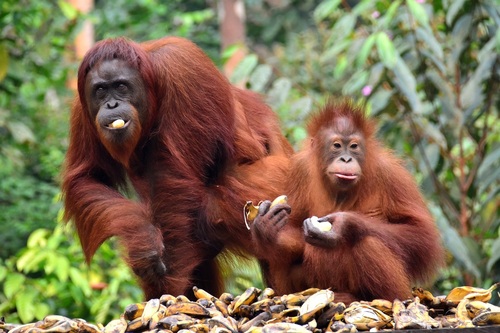
Bornean orangutan
The Bornean orangutan, with its vibrant orange coat and contemplative gaze, roams Borneo's lush rainforests. Known for its arboreal lifestyle, it plays a vital ecological role, dispersing seeds throughout the forest. Its gentle nature and remarkable tool-use make it a captivating symbol of tropical biodiversity.
30-40 years
Lifespan
30.0 - 90.0 kg
Weight
Height: 1.25 - 1.5 m
Size
Brown, Grey, Red, Black, Orange
Color
12-15 years
Age of Sexual Maturity
3 years
Age of Weaning
2.7 mph
Top Speed
Critically Endangered
Conservation Status
Decreasing
Population Trend
Characteristics
The Bornean orangutan, Pongo pygmaeus, inhabits the tropical rainforests of Borneo. This arboreal ape is known for its striking orange fur, long arms, and intelligence. Primarily solitary, it feeds on fruit and leaves, playing a crucial role in seed dispersal. Its gentle demeanor and tool use are notable.
Distribution Range of the Bornean orangutan
Pongo pygmaeus, commonly known as the Bornean orangutan, is native to the island of Borneo. This island is politically divided among three countries: Indonesia, Malaysia, and Brunei. The Bornean orangutan is primarily found in the Indonesian provinces of Kalimantan and the Malaysian states of Sarawak and Sabah.
Bornean orangutan's Habitat
Environmental Conditions
The Bornean orangutan inhabits tropical and subtropical moist broadleaf forests. These forests are characterized by a humid climate with significant rainfall, ranging from 2,000 to 4,500 mm annually. The temperature in these regions is typically warm year-round, averaging between 24°C to 28°C. The forest canopy provides a complex three-dimensional environment that supports a rich diversity of plant and animal life.
Ecological Niche
Bornean orangutans occupy an arboreal niche, spending the majority of their lives in trees. They are frugivorous, with fruit constituting a major part of their diet, although they also consume leaves, bark, and insects. Their role as seed dispersers is crucial for forest regeneration. The species' preference for lowland dipterocarp forests, peat swamp forests, and occasionally mountainous areas highlights their adaptability to different forest types, albeit with a strong preference for primary forests.
Copyright @ Nature Style Limited. All Rights Reserved.
 English
English